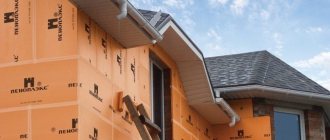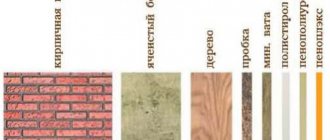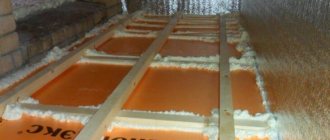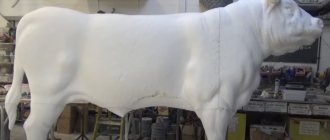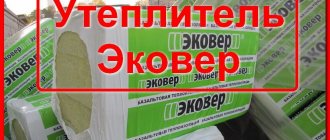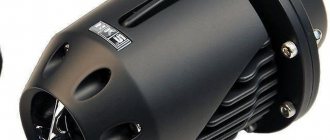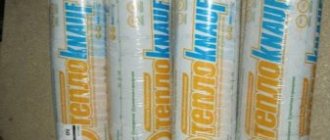Extruded polystyrene foam (EPS) is available in slab form . It is often called penoplex. But you should know that penoplex is a brand (the same as “Giprok” - drywall or “Macroflex” - polyurethane foam). The structure of the insulation under consideration is similar to the structure of conventional polystyrene foam. Being a subtype of polystyrene foam, penoplex is distinguished by its higher density and strength, and has a fine-celled, homogeneous structure consisting of almost completely closed cells. This material is the best type of polystyrene plastic. EPS (penoplex) is made by extrusion, as a result of which polystyrene beads melt, forming a homogeneous mass, which is poured into a mold, where it cools. In this article we will take a detailed look at penoplex insulation, its technical characteristics, advantages, applications and installation features .
Extruded polystyrene foam Penoplex
Extruded polystyrene foam (EPS or XPS) is a modern thermal insulation material that appeared no more than 20 years ago, but managed to win the love of ordinary people thanks to its ability to solve a number of complex problems:
- provide reliable thermal insulation;
- reduce heating costs;
- ensure a healthy indoor microclimate.
is one of the largest domestic companies in the production of thermal insulation materials, and the undisputed leader in the production of extruded polystyrene foam, to which the popular name “penoplex” (sometimes spelled “penoplex”) is assigned.
Details about the characteristics
Extruded polystyrene foam has gained popularity due to its excellent performance and quality characteristics.
Extruded polystyrene foam has gained popularity due to its excellent performance and quality characteristics. In many respects, the insulation is superior to all known thermal insulation materials.
Penoplex production
For the production of expanded polystyrene foamplex, a special extruded installation is used. Granulated polystyrene foam (foam) is loaded into the unit's container, to which catalyst gases are added during the heating process. During the chemical reaction, polystyrene foam begins to foam, turning into a porous mass and increasing in size.
The resulting material is pushed out under pressure. Here the gas evaporates from it, and it gradually hardens. The resulting mass is orange in color and has a bubbly structure. Next, it is fed to machines, where it is cut into smooth, familiar to the consumer’s eye, penoplex slabs.
The high thermal insulation qualities of EPS are ensured by the unique structure of the material. Expanded polystyrene has a fine-cell porous structure (cell diameter from 0.1 to 0.3 mm), each of which is isolated from each other.
What is this. History of the creation of the material
The material first appeared back in 1941, when the DOW CHEMICAL company (USA) patented a fundamentally new product with high thermal insulation properties and moisture resistance. The production of the material was put on stream, but initially it was manufactured only for the needs of the Navy.
Due to its resistance to wet environments, Penoplex has been used for the production of life rafts. After some time, the material began to be used in refrigeration units. Penoplex occupied its rightful niche only in 1950, when it began to be used in construction. It is curious that in the US construction market the material is known under the brand name STROYFOAM.
Penoplex is a Russian brand that appeared only in 1988.
What is Penoplex? Essentially, it is foamed polystyrene, which is produced on extrusion machines. In its structure, the material resembles polystyrene foam, which is familiar to many, but has a denser structure and, accordingly, better characteristics.
The difference between penoplex and polystyrene foam
Both expanded polystyrene (EPS) and polystyrene foam (EPS) are produced from the same raw materials. However, thanks to a special manufacturing technology, penoplex receives heat treatment during the production process, making it much stronger. This circumstance allows EPS boards to better withstand mechanical loads and not collapse in those circumstances where the foam plastic is deformed, crumbles and ceases to perform its functions.
Moreover, given its specific structure, penoplex has lower vapor permeability, which means it retains heat better. And experiments prove that extruded polystyrene foam is superior to polystyrene foam and other insulation materials in terms of thermal characteristics. A good example: 20 mm thick penoplex can retain heat with the same efficiency as 30 mm polystyrene foam, 40 mm mineral wool or 400 mm thick brickwork.
What is it made of? Compound
We have before us a completely artificial material, which is made from chemical components mixed in certain proportions. The technology involves using a temperature of 140 degrees, which causes the ingredients to melt and foam, forming porophores. If we talk about specifics, the following materials are used in production:
- Polystyrene.
- Ground perlite.
- Lemon acid.
- Tetrabromoparaxylene.
- Barium or zinc stearate.
- Bicarbonate of soda.
The use of such components in certain proportions forms a strong cellular-porous structure filled with gas.
Scope of application of penoplex
Taking into account the special characteristics, this type of insulation is most often used to insulate those surfaces for which resistance to loads with virtually zero vapor conductivity is important.
Let's consider the scope of application of this material:
- insulation of floors (placed under the screed, on the screed or between layers);
- arrangement of thermal insulation under electric or water heated floors;
- creating a blind area around the perimeter of the house;
- insulation of the basement (not residential);
- insulation of paths, areas for gazebos;
- insulation of wells;
- thermal insulation of pipelines, gas and oil pipelines;
- roof insulation.
In addition, Penoplex is used to insulate the external and internal walls of the house. The truth here is that you must keep in mind that the material in question practically does not allow steam to pass through, which means that before making a choice in favor of EPS, you need to think about arranging ventilation. Otherwise, a house lined with polystyrene foam will be too hot and humid.
Moreover, before insulating the facade with Penoplex, it is important to calculate the thickness of the insulation boards. The wrong choice can lead to the fact that the dew point will not be in the insulation, but in the wall, which is why fungus and mold will appear on the inner surface of the wall.
Types of Penoplex
A huge advantage is that this company produces several types of expanded polystyrene depending on the application.
Penoplex FOUNDATION. Suitable for floor insulation, as it has increased strength, but low fire resistance requirements. Ideal for laying on sand-cement screed. Grooves are cut out on one of the planes of this insulation, which provide better adhesion of the heat insulator to the floor surface.
Penoplex COMFORT. This is a universal material that can be used for almost any purpose, from insulating the facade of a country house to thermal insulation of a loggia in an apartment. Very often this material is used to insulate a bathhouse or country house, and all because this type of insulation is characterized by increased frost resistance. The L-shaped edge of this material helps eliminate areas of freezing in the insulation.
Penoplex WALL. Extruded polystyrene foam, optimal for insulating vertical structures (external and internal walls of the house, as well as partitions). Like the COMFORT model, these plates have an L-shaped profile.
Penoplex ROOFING. This brand produces roofing insulation, which due to its properties is optimally suited for thermal insulation of the roof. Such plates have a U-shaped edge, which provides the most reliable connection.
Important! The ability of roofing insulation to prevent cold air from entering the room is a definite plus. However, you need to think about how to remove excess moisture from the attic. If these slabs are installed, they will require high-quality ventilation. In this case, one dormer window will not be enough.
Penoplex BASE. This version of the slabs is used to insulate the walls of basements and basements.
Penoplex FACADE. This option is optimal for insulating the facade surfaces of buildings and structures.
Penoplex BLOCK. This is a special block with a thickness of 120 to 1000 mm, which is used in the construction of roads, highways and runways.
Penoplex segments. This category produces semi-cylindrical shapes (shells), which are used for insulation of pipelines, both in private construction and in industry.
In addition to the above options, this company also produces a number of others, in particular: Penoplex GEO, Penoplex 45 and Penoplex 45C. These are universal panels with increased strength, which are used in industrial and civil construction for insulation of roads and runways, industrial buildings and structures.
Important! Penoplex 45 and Penoplex 45C are often used for the construction of permanent formwork. Such formwork not only creates the shape of a strip foundation, but also at the same time acts as insulation. For this purpose, it produces universal formwork ties. Thanks to such slabs and fasteners, you can build formwork for a full-fledged house in just a day!
Pros and cons of penoplex
In terms of technical characteristics, extruded polystyrene foam surpasses most known insulation materials. To see this, just look at its advantages:
— Low thermal conductivity
The main advantage of EPS over other insulation materials is its extremely low ability to conduct heat. An indicator of 0.032 W/m*S indicates that all the heat of your home remains in it. By the way, this figure is 9 (!) times lower than the thermal conductivity of mineral wool!
— Low water absorption
The material in question is not at all hygroscopic, despite its specific structure. The smallest bubbles are not connected to each other, and their walls are extremely strong. Suffice it to say that when a sheet of polystyrene foam is completely immersed in water, it absorbs only 0.4% of its volume per day! Moreover, even if you leave such material in water for 30 days, it will not be saturated with moisture even by 1%!
Important! Moisture resistance is a rare quality for insulation, and therefore penoplex is practically the only thermal insulator that can be used to insulate basements and basement floors, that is, surfaces with high humidity.
— Resistance to mechanical loads
Another important advantage of this insulation over other heat-insulating materials is its high strength. Even when pressed by hand, the slab is practically not pressed, and speaking in numbers, the strength of the material, depending on the brand, ranges from 25 to 55 kg per 1 sq. m.
Important! Penoplex will not collapse even under heavy loads when laid on the floor. The main thing is to lay it on a flat surface.
— Light weight
With high strength and thermal insulation characteristics, extruded polystyrene foam is amazingly lightweight. Thanks to this feature, the insulation does not create additional load on the home. Therefore, today expanded polystyrene can increasingly be seen on the walls of multi-story buildings.
Important! The light weight of penoplex does not weigh down the structure, and therefore insulating walls with such material does not require additional approvals or installation permission.
— Ease of processing and installation
The lightness of the insulation makes it easy to lift the slabs to a height and mount them on the wall, even alone. And this is a significant saving of money, time and effort. Add to this the fact that polystyrene foam, if necessary, can be easily cut even with a sharp construction knife. But still, it is better to do this with a hot string, because hardly anyone will like the sound of metal rubbing against polystyrene.
Important! Extruded polystyrene foam boards are distinguished by special stepped edges. Thanks to them, it is convenient to join the insulation together, but more importantly, such a connection helps to avoid cold bridges, which are characteristic of the joints of other thermal insulation materials (the same polystyrene foam).
— Duration of operation
According to the manufacturers, the declared service life of the insulation in question is 50 years. Considering that only 20 years have passed since the invention of this material, it is quite early to say this. However, considering that over a 20-year service life, penoplex has not lost even 2% of its qualities, there is no doubt that the material will overcome the declared limit and even exceed it!
— High frost resistance
The material in question tolerates low and high temperatures well, without changing its characteristics in the range from -70ºC to +70ºC. Such indicators make it possible to use polystyrene foam boards for insulating houses and buildings even in Siberia.
Moreover, this material is able to withstand 25 freeze-thaw cycles, which only confirms the constant quality of the insulation.
— Resistance to chemicals
Penoplex does not lose its properties upon contact with most chemicals used in construction. It does not react to ammonia, propane or butane, it does not care about solvents, alcohol compounds and bleach. However, it is better not to contact polystyrene foam with some substances. Practice shows that interaction with acetone, gasoline, white spirit, toluene, formaldehyde and enamel paints can dissolve this heat insulator, depriving it of such valuable properties.
Important! To avoid problems with fixing the insulation to the surface, purchase Fast Fix foam adhesive from PENOPLEX along with Penoplex boards.
— Resistance to insects and rodents
The advantages of this insulation include the fact that penoplex is absolutely uninteresting to insects and rodents. Mice and rats do not eat this material and are not inclined to create their nests inside the panels. However, if necessary, rodents can easily chew passages inside polystyrene foam.
Having learned a number of advantages of penoplex, let's look at its disadvantages:
— Low vapor permeability
We have already mentioned that due to the extremely low vapor permeability of 0.005 mg/(m.h.Pa), penoplex deprives the walls of the house of the ability to pass air and creates a “thermos” effect indoors. Because of this feature, the healthy microclimate inside the room is disrupted. In this regard, fans of natural humidity regulation should look for another thermal insulator or think about how to ensure regular ventilation of the premises.
— Flammability
Penoplex is a flammable material. According to a special scale, it has a flammability degree of G4. Because of this feature, the heat insulator in question is not used in places where the heating temperature can exceed 80°C. Thus, penoplex should not be used to insulate areas located next to heating devices (stove, fireplace), as well as in front of an open flame.
Important! During the combustion process, polystyrene foam begins to smoke heavily, filling the surrounding space with caustic toxic substances that can threaten human health and life. For this reason, penoplex is rarely used to insulate walls in residential premises.
Fortunately, recently manufacturers have been adding fire retardants when making slabs. Thanks to these substances, the ignited polystyrene foam immediately goes out.
— Poor sound insulation
Extruded polystyrene foam is a high-quality insulation material, but not the best sound insulator. The indicator of penoplex, 50 mm thick, equal to 41 decibels, suggests that such insulation is not suitable for people who live near busy highways, railways and airports. It simply will not protect your home from extraneous noise. As a solution to the issue, EPS boards can be used in combination with plasterboard.
— Destruction under the influence of ultraviolet light
A material such as polystyrene foam does not tolerate exposure to sunlight, gradually beginning to deteriorate and lose its thermal insulation properties. For this reason, when covering a facade or using penoplex on the street for other purposes, it must be hidden behind a screed or finishing materials.
— Not suitable for insulating wooden surfaces
Expanded polystyrene is not used for insulating wooden buildings, and this is all due to the low vapor conductivity of this material. Without allowing air to pass through, this insulation contributes to the accumulation of condensation on the surface of the wood, which is why it begins to become covered with fungus and subsequently rot.
Coefficient of thermal conductivity
Low thermal conductivity allows for effective insulation. The coefficient is almost 10 times lower than that of high-quality mineral wool. Penoplex has a thermal conductivity coefficient at 25±5°C of 0.032 W/(m•°K).
Low vapor permeability
The vapor permeability of the material is almost zero.
This allows for better thermal insulation, but can lead to condensation, so it is not recommended to use penoplex when insulating baths and saunas.
Moisture resistance
The material has a high moisture resistance, which allows such insulation to be carried out without additional waterproofing. Moisture absorption is practically zero.
Methods for installing penoplex
Fixation of polystyrene foam panels, depending on the working surface, may differ. According to professionals, there are three ways to attach slabs:
1) Application of glue or mastic. This is a universal, and therefore the most common option for fixing penoplex, which is used for laying slabs on the floor or installing insulation on the wall. This method of fixation is especially typical for floor slabs, on the surface of which there are milled grooves. As a rule, after fixing the heat-insulating boards with glue, they are filled with screed on top (if we are talking about floor insulation), or plastered (if the boards are fixed to the walls).
2) Use of umbrella dowels. Fixing polystyrene foam with disc dowels is used when insulating facade walls, as well as any other vertical or inclined surfaces on which the insulation does not create a load. This includes insulation of the external and internal walls of the house, thermal insulation of the basement or loggia.
Important! To insulate the facade of a house, the thickness of the insulation must be at least 100 mm (optimally 120 mm). If you purchased thinner insulation, you can lay the slabs in two layers. It is only important to lay them staggered so that the surface layer overlaps the joints of the previous layer.
3) Application of polyurethane foam. In addition to slabs, it also produces polyurethane foam, which has a high degree of adhesion and is therefore optimally suited for fixing the heat insulator in question. This fixing method is also universal and is suitable for fixing slabs to the floor, walls and even sheer roof surfaces.
Long service life
The manufacturer claims a minimum service life of 50 years. However, there is no exact data available, since extruded polystyrene foam has been produced for insulation only since 1998.
Compressive strength
The compressive strength of extruded polystyrene foam is high. The indicator varies depending on the line of material. On average, the compressive strength of penoplex is 0.25-0.5 MPa. The higher the number, the greater the load the insulation will withstand.
Environmental friendliness
Despite the fact that the insulation is made from polymers, it does not harm the environment because it does not react with aggressive substances. Only when burning can harmful smoke be released, which can harm a person. Otherwise, penoplex does not harm a person. use during insulation does not require the use of personal protective equipment.
Fireproof properties
According to the flammability class, the material belongs to highly and moderately flammable (G3-G4). In this case, penoplex burns only when exposed to direct fire. In other situations, it smolders and is not able to sustain combustion on its own. Manufacturers strive to reduce the flammability of insulation by adding fire retardants.
The main stages of installing penoplex
In most cases, the steps for attaching polystyrene foam boards are very similar, and look like this:
1) Surface preparation. Before laying thermal insulation boards, the surface should be prepared by removing dirt and removing the previous finishing material. Wallpaper or old paint should be removed with a spatula, and if there is mold on the wall, it should be removed with copper sulfate or its substitutes.
It is important to remove all bulges so that the slabs fit evenly against each other, and if there is a curved edge, they engage perfectly. If there are recesses on the working surface, they should be plastered.
Important! Before laying polystyrene foam on the floor, the surface can be filled with screed. The option in which penoplex is laid on the poured screed, which in turn is covered with another screed (including a “warm floor” system), is considered the most optimal.
2) Installation of insulation. Expanded polystyrene slabs can be laid on the prepared surface. If there are L-shaped or U-shaped grooves at the ends of the insulation, the plates must be installed sequentially, engaging.
3) Finishing work. After fixing the heat-insulating material to the walls, the surface is covered with reinforcing stack on top, and then an adhesive composition is applied to it and finishing is carried out. If the roof is insulated, the surface of the polystyrene foam is covered with a vapor barrier film, after which the inner surface of the roof is sheathed with plasterboard, clapboard or any other finishing material.
Tips for fastening penoplex boards
1) It is optimal to use 6 dowels per slab. Dowels are optimal for thin slabs. In this case, fasteners can be installed anywhere on the slab, in the corners, in the middle or at the seams. It is considered optimal to install 6 dowels on the slab, at an equidistant distance from each other. In this case, it is customary to retreat 15 cm from the edges.
2) When using mastic, ventilate the room. If you work with mastic while insulating a room, be sure to ensure good ventilation of the room. Mastic contains chemical compounds that can negatively affect your health. Mastic is applied in different ways - in stripes along the entire length of the slab, in a square along the perimeter, or in large dots over the entire area of the insulation.
3) Fixation with glue and umbrella dowels. The most reliable fixation involves an adhesive connection in combination with the installation of umbrella dowels. This type of fastening is recommended when insulating the facade and basement of a house. In general, in most cases, to fix penoplex it is enough to place the slabs on glue, but in the case of attaching insulation to a vertical wall, such fixation should always be supplemented with dowels.
4) The joints must be filled with polyurethane foam. The joints and cracks remaining after installing the insulation are filled with polyurethane foam.
5) Complete drying for at least 3 days. At least 3 days must pass before the fixed insulation dries completely. After this, you can begin finishing work.
Penoplex is an excellent choice for insulating your own home. The company that produces this heat insulator has affordable prices, and penoplex itself is easy to attach to the surface even without experience in construction.
